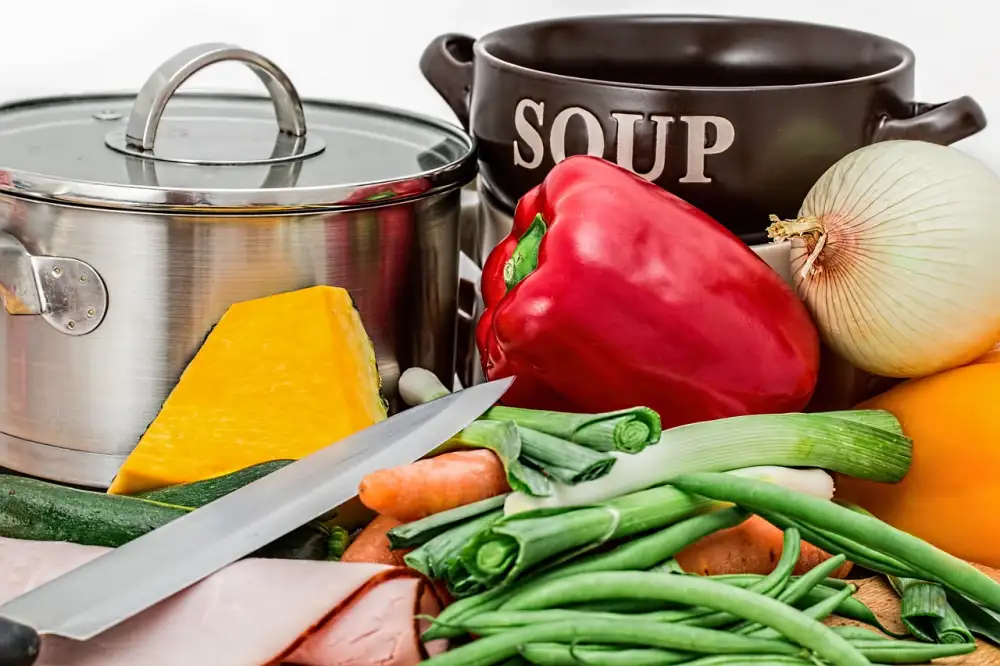Delicious Low Sodium Recipes: Savor the Flavor without the Salt

In today's fast-paced world, where processed foods and takeout meals have become the norm, it's easy to overlook the importance of a low sodium diet. However, reducing our sodium intake is crucial for maintaining good health and preventing various diseases. That's why we're here to introduce you to the wonderful world of low sodium recipes.
Low sodium recipes are not only delicious but also beneficial for our overall well-being. By cutting back on salt and incorporating flavorful alternatives, we can savor the true taste of food without compromising our health. Whether you're looking to lower your blood pressure or simply want to make healthier choices in your daily meals, these recipes are perfect for you.
Join us as we explore the benefits of a low sodium diet, understand the effects of sodium on our health, and discover tips and tricks for reducing sodium in our meals. Get ready to embark on a culinary journey filled with mouthwatering breakfasts, satisfying lunches, delectable dinners, tempting snacks, and indulgent desserts – all with low sodium options that will leave you craving for more.
So let's dive into this exciting world of low sodium recipes and learn how we can savor the flavor without the salt!
Benefits of a Low Sodium Diet
A low sodium diet offers numerous benefits for your overall health and well-being. By reducing your sodium intake, you can lower your blood pressure and decrease the risk of heart disease, stroke, and kidney problems. Additionally, a low sodium diet can help manage fluid retention and reduce swelling in the body. It also promotes healthy weight management by preventing water retention and bloating. Furthermore, a low sodium diet encourages the consumption of whole foods such as fruits, vegetables, and lean proteins, which are rich in essential nutrients. Embracing a low sodium lifestyle can lead to improved cardiovascular health and increased energy levels.
Understanding Sodium and its Effects on Health
Sodium is a mineral that is essential for our body to function properly. It helps maintain fluid balance, nerve function, and muscle contractions. However, consuming too much sodium can have detrimental effects on our health.
High sodium intake has been linked to an increased risk of high blood pressure, heart disease, stroke, and kidney problems. Excess sodium in the diet can cause the body to retain water, leading to bloating and swelling. It can also put strain on the kidneys as they work harder to eliminate the excess sodium.
It is recommended that adults consume no more than 2,300 milligrams of sodium per day, which is about one teaspoon of salt. However, most people consume far more than this amount due to the prevalence of processed foods and restaurant meals that are high in sodium.
By understanding the effects of sodium on our health, we can make informed choices about our diet and take steps towards reducing our sodium intake.
Tips for Reducing Sodium in Your Meals
Reducing sodium in your meals doesn't mean sacrificing flavor. Here are some tips to help you cut back on sodium without compromising taste. First, read food labels carefully and choose low-sodium or no-salt-added options. Secondly, cook from scratch using fresh ingredients instead of relying on processed foods. Thirdly, limit the use of salt in your cooking by using herbs, spices, and citrus juices to enhance flavors. Additionally, rinse canned vegetables or beans to remove excess sodium. Finally, be mindful of condiments and sauces that can be high in sodium and opt for homemade versions with reduced salt content. By following these tips, you can enjoy delicious meals while reducing your sodium intake.
Flavorful Low Sodium Substitutes
Reducing sodium in your meals doesn't mean sacrificing taste. There are plenty of flavorful low sodium substitutes that can add a burst of flavor to your dishes without the need for excessive salt. Here are some options to consider:
1. Herbs and Spices: Experiment with a variety of herbs and spices to enhance the taste of your meals. Basil, oregano, thyme, and rosemary are great choices for adding depth to savory dishes, while cinnamon, nutmeg, and vanilla can elevate the flavors in desserts.
2. Citrus Fruits: The natural acidity in citrus fruits like lemons, limes, and oranges can brighten up any dish. Squeeze some fresh lemon juice over roasted vegetables or use citrus zest to add a tangy kick to marinades and dressings.
3. Vinegars: Balsamic vinegar, apple cider vinegar, and red wine vinegar are excellent alternatives to salt when it comes to adding tanginess to your recipes. Use them as a base for salad dressings or drizzle them over grilled meats and vegetables.
4. Garlic and Onion: These aromatic ingredients can provide a savory punch without relying on salt. Incorporate minced garlic or onions into your cooking process for added flavor complexity.
5. Low Sodium Soy Sauce: Opt for low sodium soy sauce instead of regular soy sauce to reduce sodium intake while still enjoying the umami flavor it brings to stir-fries and marinades.
By incorporating these flavorful low sodium substitutes into your cooking repertoire, you can savor the taste without compromising on health.
Breakfast Low Sodium Recipes
Breakfast is often considered the most important meal of the day, and with low sodium recipes, you can start your day off right without sacrificing flavor. Here are a few delicious options to try:
1. Veggie Omelette: Whip up a fluffy omelette filled with sautéed vegetables like bell peppers, onions, and spinach. Season it with herbs and spices instead of salt for a burst of flavor.
2. Avocado Toast: Spread mashed avocado on whole grain toast and top it with sliced tomatoes and a sprinkle of black pepper. This simple yet satisfying dish is packed with healthy fats and nutrients.
3. Yogurt Parfait: Layer low sodium granola, fresh berries, and plain Greek yogurt in a glass for a nutritious and filling breakfast treat. Drizzle it with honey or sprinkle cinnamon for added sweetness.
4. Quinoa Breakfast Bowl: Cook quinoa in low sodium vegetable broth and top it with steamed vegetables, poached eggs, and a drizzle of olive oil. This protein-packed bowl will keep you energized throughout the morning.
5. Banana Pancakes: Mash ripe bananas and mix them with whole wheat flour, eggs, vanilla extract, and baking powder to make fluffy pancakes without adding any salt. Serve them with fresh fruit or a dollop of Greek yogurt.
By incorporating these low sodium breakfast recipes into your daily routine, you can enjoy a delicious start to your day while maintaining a heart-healthy lifestyle.
Lunch Low Sodium Recipes
Lunchtime can be a challenge when trying to stick to a low sodium diet, as many pre-packaged options are loaded with salt. But fear not, there are plenty of delicious and satisfying low sodium recipes for lunch that will keep you on track.
One option is a refreshing Greek salad with grilled chicken. Simply toss together crisp lettuce, juicy tomatoes, cucumber slices, red onion, Kalamata olives, and feta cheese. Top it off with some grilled chicken breast for added protein. For the dressing, skip the store-bought varieties and make your own using olive oil, lemon juice, garlic, and herbs.
Another tasty choice is a veggie-packed quinoa salad. Cook quinoa according to package instructions and let it cool. Then mix in chopped bell peppers, cherry tomatoes, cucumbers, red onion, and fresh herbs like parsley or basil. Drizzle with a homemade vinaigrette made from olive oil, vinegar or lemon juice, Dijon mustard, and a touch of honey.
If you're in the mood for something warm and comforting, try making a hearty vegetable soup. Start by sautéing onions and garlic in olive oil until fragrant. Add in diced carrots, celery, zucchini, and any other veggies you like. Pour in low sodium vegetable broth and simmer until the vegetables are tender. Season with herbs like thyme or rosemary for extra flavor.
For those who prefer sandwiches for lunchtime fare, opt for a turkey avocado wrap. Spread mashed avocado on a whole wheat tortilla and layer on sliced turkey breast along with lettuce leaves and tomato slices. Roll it up tightly and enjoy!
With these tasty low sodium lunch recipes at your disposal, you can savor your midday meal without sacrificing flavor or healthiness.
Dinner Low Sodium Recipes
Dinner is often the main meal of the day, and it's important to make it both delicious and low in sodium. Here are some flavorful low sodium recipes that will satisfy your taste buds without compromising your health.
1. Grilled Lemon Herb Chicken: Marinate chicken breasts in a mixture of lemon juice, garlic, and herbs like rosemary and thyme. Grill until cooked through and serve with a side of steamed vegetables for a nutritious and low sodium dinner option.
2. Baked Salmon with Dill Sauce: Season salmon fillets with lemon pepper seasoning and bake until flaky. Top with a homemade dill sauce made from Greek yogurt, fresh dill, and lemon juice. Serve with quinoa or brown rice for a complete meal.
3. Vegetable Stir-Fry: Sauté an assortment of colorful vegetables like bell peppers, broccoli, carrots, and snap peas in olive oil. Add low sodium soy sauce or tamari for flavor. Serve over brown rice or whole wheat noodles for a satisfying dinner that's packed with nutrients.
4. Turkey Meatballs with Marinara Sauce: Combine ground turkey, breadcrumbs, egg whites, minced garlic, onion powder, and Italian seasoning to make flavorful meatballs. Bake in the oven until cooked through and serve with homemade marinara sauce made from low sodium canned tomatoes.
5. Quinoa Stuffed Bell Peppers: Cook quinoa according to package instructions and mix it with sautéed onions, garlic, black beans, corn kernels, diced tomatoes, and spices like cumin and chili powder. Stuff the mixture into halved bell peppers and bake until tender.
These dinner recipes prove that you don't need excessive salt to create delicious meals. By using herbs, spices, citrus juices, and other flavorful ingredients as substitutes for salt, you can enjoy tasty dinners while maintaining a low sodium lifestyle.
Snacks and Appetizers Low in Sodium
Snacks and appetizers are an essential part of any gathering or meal. However, many store-bought options are loaded with sodium, which can be detrimental to our health. Fortunately, there are plenty of delicious low sodium alternatives that will still satisfy your cravings.
One simple yet flavorful option is a vegetable platter with a homemade low sodium dip. Chop up an assortment of fresh vegetables such as carrots, celery, bell peppers, and cherry tomatoes. For the dip, mix together plain Greek yogurt, lemon juice, garlic powder, and herbs like dill or parsley. This dip is not only low in sodium but also high in protein and nutrients.
Another great snack idea is air-popped popcorn sprinkled with herbs and spices instead of salt. You can experiment with different combinations like garlic powder, paprika, cayenne pepper, or even nutritional yeast for a cheesy flavor without the sodium.
For those who enjoy something crunchy and savory, try making your own baked tortilla chips. Cut corn tortillas into triangles and arrange them on a baking sheet. Lightly spray them with olive oil and sprinkle with a mixture of chili powder, cumin, and garlic powder before baking until crispy. These chips are not only low in sodium but also much healthier than their fried counterparts.
If you're looking for something more substantial, consider making homemade hummus using low sodium canned chickpeas or cooking dried chickpeas from scratch. Blend the chickpeas with tahini paste, lemon juice, garlic cloves, and olive oil until smooth. You can add flavor by incorporating roasted red peppers or fresh herbs like basil or cilantro.
By opting for these low sodium snacks and appetizers instead of their high-sodium counterparts, you can still enjoy delicious flavors while taking care of your health. So next time you're planning a gathering or simply want to indulge yourself guilt-free, reach for these tasty options that won't compromise your commitment to a low sodium lifestyle.
Desserts with Low Sodium Options
Desserts are often associated with indulgence and sweetness, but that doesn't mean they have to be high in sodium. There are plenty of delicious dessert options that can satisfy your sweet tooth without adding unnecessary salt to your diet.
One popular low sodium dessert option is fruit-based desserts. Fresh fruits like berries, melons, and citrus fruits are naturally low in sodium and packed with vitamins and antioxidants. You can enjoy them on their own or get creative by making fruit salads, smoothies, or even fruit parfaits with a dollop of low sodium yogurt.
Another great option is homemade baked goods. By using low sodium substitutes like unsalted butter or oil, unsweetened applesauce instead of salted butter, and reducing the amount of added sugar, you can still enjoy cookies, cakes, and muffins without sacrificing flavor.
If you're a chocolate lover, fear not! Dark chocolate with a high cocoa percentage tends to have less sodium compared to milk chocolate. You can satisfy your chocolate cravings by enjoying a small piece of dark chocolate or incorporating it into recipes like flourless chocolate cake or chocolate mousse made with low sodium ingredients.
Lastly, don't forget about frozen treats. Instead of reaching for store-bought ice cream loaded with sodium, try making your own frozen desserts at home. You can blend frozen bananas for a creamy "nice cream" or make popsicles using fresh fruit juice or yogurt.
Remember, when it comes to desserts with low sodium options, the key is to focus on natural flavors from ingredients like fruits and spices rather than relying on added salt. With a little creativity and some simple swaps in your recipes, you can savor the sweetness while keeping your sodium intake in check.
In conclusion, embracing a low sodium lifestyle can have numerous benefits for your health and overall well-being. By reducing your sodium intake, you can lower your risk of developing high blood pressure, heart disease, and stroke. Additionally, a low sodium diet can help improve kidney function and reduce fluid retention.
While it may take some time to adjust to the taste of low sodium foods, there are plenty of flavorful alternatives and substitutes available. Experiment with herbs, spices, and other seasonings to enhance the taste of your meals without relying on salt.
Remember that small changes can make a big difference. Start by gradually reducing the amount of salt you use in your cooking and at the table. Be mindful of hidden sources of sodium in processed foods and choose fresh ingredients whenever possible.
By incorporating delicious low sodium recipes into your daily routine, you can savor the flavor without compromising your health. So why not start today? Your taste buds and your body will thank you for it!
Published: 06. 12. 2023
Category: Food



